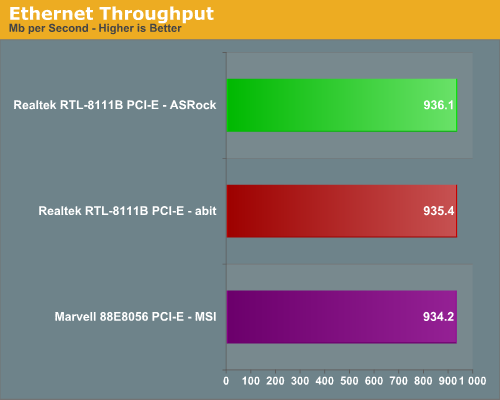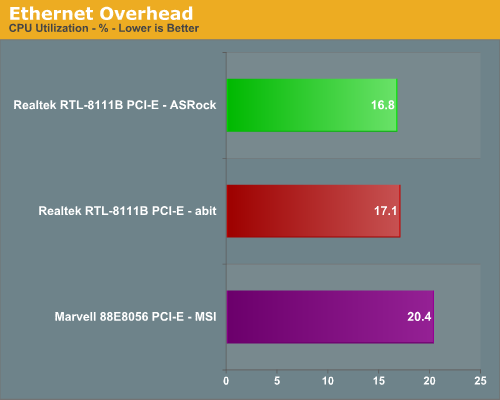µATX Part 1: ATI Radeon Xpress 1250 Performance Review
by Gary Key on August 28, 2007 7:00 AM EST- Posted in
- Motherboards
Ethernet Performance
LAN performance is also an area worth looking at, as these boards might be serving up media to the rest of the house. All of these boards utilize PCI or PCI Express based controllers with the only difference being the supplier of the core logic.
The Windows 2000 Driver Development Kit (DDK) includes a useful LAN testing utility called NTttcp. We used the NTttcp tool to test Ethernet throughput and the CPU utilization of the various Ethernet Controllers used on the Intel motherboards. We set up one machine as the server; in this test, an Intel system with an Intel CSA Gigabit LAN connection. Intel CSA has a reputation for providing fast throughput and is a logical choice for our Gigabit LAN server.
On the server side, we used the following Command Line as suggested by the VIA whitepaper on LAN testing:


Both the CPU utilization and throughput performance favors the Realtek Gigabit controllers with the ASRock implementation offering the best combination. However, the differences are slight and will not be noticed under normal operating circumstances.


Our NTttcp test represents the absolute best throughput scenario for our network controllers and will rarely be duplicated under normal usage patterns across an office or home LAN. We decided to create an application test that would represent typical usage patterns in a home Gigabit and 10/100 network setup. Unfortunately, we have not been successful over the course of the past couple of months in creating a test that is repeatable and does not contain issues brought on by the Vista operating system.
Our top screenshot shows the initial results of transferring a 996MB AVI file across our LAN. The first data series is the transfer of the file from our source machine to the target machine without any activity on either machine except for the transfer itself. The second data series shows the same file being transferred only our target machine is playing the official Windows Vista song, Wow is Now(yes, our sense of humor is a little warped). The second screenshot shows the same file being transferred from the target machine back to the source machine. We have noticed this problem and others for some time in our network testing with Vista. Playing any type of music or video streams with a wide variety of playback programs results in a throughput drop of up to 90% at times during file transfers under Vista.
The other bug that we have experienced at random times is that the transfer speed will be hard capped at a five to ten percent usage rate. This last bug has been reported by several users across various forums and is one that we can duplicate periodically on our Gigabit LAN but not always. We have replicated both problems on a wide variety of setups (100Mb and 1Gb) but the hard cap bug does not always occur which is still puzzling to us. Then again the whole "new and improved" Vista network stack and resulting performance losses we have discussed with Microsoft since Vista's launch are even more puzzling.
Microsoft has confirmed the reductions in network performance during multimedia playback are directly connected to the new Multimedia Class Scheduler Service (MMCSS) that's part of Vista. A detailed explanation of the problem and resulting ideas to fix it is available here. For now, we will continue to rely on the NTttcp testing until Microsoft has this particular problem fixed.
LAN performance is also an area worth looking at, as these boards might be serving up media to the rest of the house. All of these boards utilize PCI or PCI Express based controllers with the only difference being the supplier of the core logic.
The Windows 2000 Driver Development Kit (DDK) includes a useful LAN testing utility called NTttcp. We used the NTttcp tool to test Ethernet throughput and the CPU utilization of the various Ethernet Controllers used on the Intel motherboards. We set up one machine as the server; in this test, an Intel system with an Intel CSA Gigabit LAN connection. Intel CSA has a reputation for providing fast throughput and is a logical choice for our Gigabit LAN server.
On the server side, we used the following Command Line as suggested by the VIA whitepaper on LAN testing:
Ntttcpr -m 4,0,‹server IP› -a 4 -l 256000 -n 30000Ntttcps -m 4,0,‹client IP› -a 4 -l 256000 -n 30000

Both the CPU utilization and throughput performance favors the Realtek Gigabit controllers with the ASRock implementation offering the best combination. However, the differences are slight and will not be noticed under normal operating circumstances.


Our NTttcp test represents the absolute best throughput scenario for our network controllers and will rarely be duplicated under normal usage patterns across an office or home LAN. We decided to create an application test that would represent typical usage patterns in a home Gigabit and 10/100 network setup. Unfortunately, we have not been successful over the course of the past couple of months in creating a test that is repeatable and does not contain issues brought on by the Vista operating system.
Our top screenshot shows the initial results of transferring a 996MB AVI file across our LAN. The first data series is the transfer of the file from our source machine to the target machine without any activity on either machine except for the transfer itself. The second data series shows the same file being transferred only our target machine is playing the official Windows Vista song, Wow is Now(yes, our sense of humor is a little warped). The second screenshot shows the same file being transferred from the target machine back to the source machine. We have noticed this problem and others for some time in our network testing with Vista. Playing any type of music or video streams with a wide variety of playback programs results in a throughput drop of up to 90% at times during file transfers under Vista.
The other bug that we have experienced at random times is that the transfer speed will be hard capped at a five to ten percent usage rate. This last bug has been reported by several users across various forums and is one that we can duplicate periodically on our Gigabit LAN but not always. We have replicated both problems on a wide variety of setups (100Mb and 1Gb) but the hard cap bug does not always occur which is still puzzling to us. Then again the whole "new and improved" Vista network stack and resulting performance losses we have discussed with Microsoft since Vista's launch are even more puzzling.
Microsoft has confirmed the reductions in network performance during multimedia playback are directly connected to the new Multimedia Class Scheduler Service (MMCSS) that's part of Vista. A detailed explanation of the problem and resulting ideas to fix it is available here. For now, we will continue to rely on the NTttcp testing until Microsoft has this particular problem fixed.










22 Comments
View All Comments
Brick88 - Thursday, August 30, 2007 - link
doesn't anyone feel that AMD is cutting itself short? Yes Intel is their primary competitor but by not producing an igp chipset for intel based processors, they are cutting themselves out of a big market. Intel ships the majority of processors and AMD will need every single stream of revenue to compete with Intel.bunga28 - Wednesday, August 29, 2007 - link
Charles Dickens would roll over his grave if he saw you comparing these 2 boards by paraphrasing his work.Myrandex - Tuesday, August 28, 2007 - link
I don't knwo why they would ever put that name on the board. the fact that it is getting beat by a ASRock motherboard in gaming performance is pathetic, since that name is supposed to be all about gaming (no offense to the ASRockers out there, as they aren't bad boards I have more experience with them then fatal1ty's anyways).Etern205 - Tuesday, August 28, 2007 - link
On the "abit Fatality F-I90HD: Feature Set" page,that Abit EQ software interface of a car looks
familar one of those real models.
Like this one
<img>http://img404.imageshack.us/img404/8490/toyotafjhh...">http://img404.imageshack.us/img404/8490/toyotafjhh...
source:
http://www.automobilemag.com/new_car_previews/2006...">http://www.automobilemag.com/new_car_previews/2006...
strikeback03 - Tuesday, August 28, 2007 - link
I was thinking Hummer, either way...Etern205 - Tuesday, August 28, 2007 - link
Not really because the face of a Hummer is differentthan the one from Toyota. The face of a Hummer has
vertical grill bars, while the Toyota does not.
strikeback03 - Wednesday, August 29, 2007 - link
However the Hummer has the full-width chrome fascia, the Toyota has a part-width sorta satin chrome thing.I highly doubt they licensed an image of either, so it can't look exactly like any vehicle. I remember a lawsuit between Jeep and Hummer over the 7 vertical slots in eachother's grilles several years ago.
eBauer - Tuesday, August 28, 2007 - link
Why are the Xpress 1250 systems running tighter timings (4-4-4-12) where the G33 system is running looser timings (5-5-5-12)?strikeback03 - Tuesday, August 28, 2007 - link
Top of page 8
Mazen - Tuesday, August 28, 2007 - link
I have a 6000+ (gift) and I am just wondering whether I should go with a 690G or wait for nvidia's upcoming MCP 78. Can't wait for the 690G review... thoughts anyone?